Types of fermentation on the basis of process & production scale
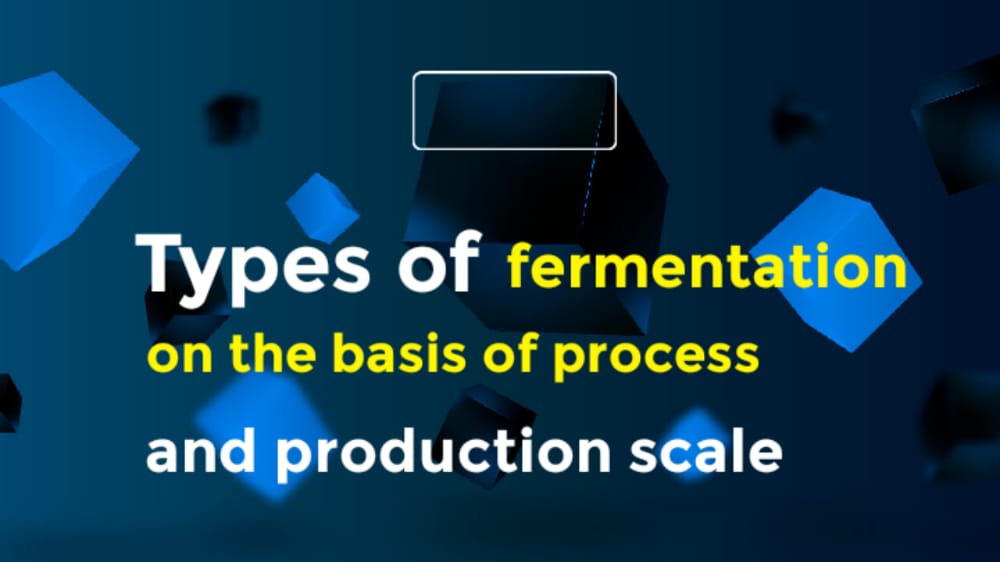
Fermentation is a metabolic process where a complex substance breaks down into simpler substances. Fermentation has countless benefits in food production, laboratory scale as well as in industrial scale. Here you will know about the types of fermentation on the basis of process and production scale.
Table of Contents
What is fermentation
A metabolic process that produces chemical changes in organic substrates the action of enzymes is known as fermentation. Fermentation is also defined as the extraction of energy from carbohydrates in the absence of oxygen.
Fermentation lets the preservation of considerable amounts of food through alcohol, acetic acid, lactic acid, and alkaline fermentations.
Types of fermentation on the basis of process and production scale:
Types of on the basis of production scale:
Laboratory scale fermentation:
- Firstly, Laboratory scale fermentation taking place in flasks and cultures could possibly be mixed through shaking in a controlled atmospheric chamber.
- Secondly, Lab-scale fermentation could be described as small-scale fermentation which runs mostly at lab scale in fermenter or flasks of different quantity.
- Thirdly, The mode of sterilization in lab-scale fermentation is ex-situ sterilization.
- Herein lab-scale fermentation, the inoculum which runs the process of fermentation is made in small flasks or in slants.
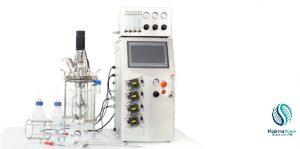
Pilot-scale fermentation:
- This type of fermentation is generally taking place in fermenters which are aerated and stirred vessels.
- Pilot-scale fermentation needs a good knowledge of not only organism’s biology but also need to know about the equipment needed for a successful process.
- The basic purpose of pilot-scale fermentation is to explain laboratory method into small scale industrial process.
- The main goal of pilot-scale fermentation is to make and enhance the method for production manufacturing.
- An effective pilot plant establishes a predictable, vigorous, and cost-effective process that generates products of efficient quality.
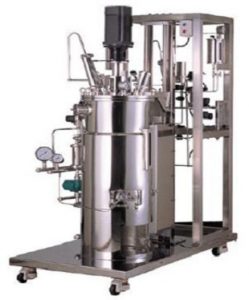
Industrial-scale fermentation:
- Industrial-scale fermentation is also taking place in fermenters which are aerated and stirred vessels.
- Scale-up is the significant element of Industrial scale fermentation. Here in industrial-scale fermentation, there is a conversion of the laboratory-scale process to an industrial process.
- It is considered as large-scale fermentation where microorganisms are used such as fungi and bacteria and also some the eukaryotic cells such as insect cells and CHO cells. These microbes are used to make products useful for humans.
- Now both recombinant and non-recombinant biotechnology products that affected our lives are made through large-scale or industrial-scale fermentation.
- Industrial-scale fermentation holds commercial targets from biofuels to personalized medicines
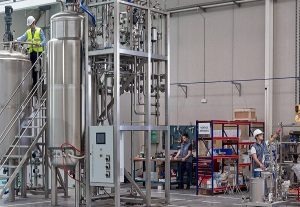
Stirred tank bioreactor:
Stirred type bioreactors are those types of bioreactors that are extensively used for culturing biological agents for example enzymes, cells, and antibodies. Here, efficient mixing is mainly obtained by internal mechanical agitations.
Components of stirred tank bioreactor:
The main components of STBrs or stirred tank bioreactors are impellers or agitators. These components offer a wide variety of functions i.e.,
- Aeration
- Heat and mass transfer
- And mixing for homogenization.
Two sorts of impellers are commonly used in the conventional fermentation industry which are radial flow impellers and axial flow impellers.
Agitator or impeller:
- An agitator is a mechanism or device which is used for putting something into motion by stirring and shaking.
- Agitation machines are of several types which include magnetic agitators, and washing machine agitators.
- Agitators are of various varieties and sizes depending on their applications.
Axial flow impellers:
- This type of impeller causes the fluid of the tank to parallelly flow to the axis of rotation of the impeller.
Radial flow impellers:
- This type of impeller causes the fluid of the tank to perpendicularly flow to the axis of rotation of the impeller.
- This impeller makes a side-to-side motion of fluid which causes high trim rates and comparatively low pumping numbers.
Applications of stirred tank bioreactor:
- Firstly, A stirred tank bioreactor is used to enhance a reliable and viable system of bioprocessing so as to treat wastewater which is rice in hydrocarbons.
- Secondly, STBr is mainly a vital and conventional bioreactor in industrial applications as it has low operational costs.
- Thirdly, The stirred tank bioreactor works mainly in a continuous operation with removal and feeding of mass and energy and is also known as a continuous stirred bioreactor.
- And Finally, The components of stirred tank bioreactors facilitate the optimization, installation, and design of these impellers in conventional fermentation that is the reason it is used in the fermentation industry.
- Most of the stirred tank bioreactor is used for suspension cultures of plant cell and these are modifications of those which are used for microbial systems.
Types of fermentation on the basis of the process:
On the basis of process, there are two types of fermentation namely; lactic acid fermentation, and alcoholic fermentation.
Lactic acid fermentation:
- This method of fermentation is mostly used by specific animals and bacteria that are present in curd or yogurt.
- Routinely, this sort of fermentation is employed in mammalian RBCs and in skeletal muscles that have an inadequate supply of oxygen to let aerobic respiration continue.
- In muscle cells, the accumulation of lactic acid must be removed by blood passage and for further metabolism, lactate is brought to the liver.
- The chemical reaction of this type of fermentation is as follows;
Pyruvic acid+ NADH⟷ lactic acid + NAD+
- In this reaction, the enzyme which is used here is lactate dehydrogenase.
- The reaction could proceed in any path but the left to right reaction is repressed by the acid condition.
- That accumulation of lactic acid was supposed to cause stiffness of muscles, soreness, fatigue yet recent research clashes this hypothesis.
- As soon as lactic acid is removed from the muscle and goes to the liver, it could be reconverted into pyruvic acid and then catabolized for energy.
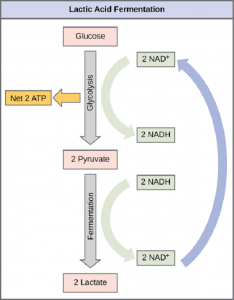
Alcoholic fermentation:
- Alcoholic fermentation is also known as ethanol fermentation because it produces ethanol which is alcohol.
- Mainly, there are mainly two reactions involved in alcoholic fermentation.
- The primary reaction is caused by pyruvate decarboxylase which is a cytoplasmic enzyme with thiamine pyrophosphate co-enzyme.
- Here a carboxyl group gets removed from pyruvic acid along with releasing CO2 gas. The loss of this CO2 gas then minimizes the molecular size by one carbon and formed acetaldehyde.
- The secondary reaction is caused by dehydrogenase alcohol to oxidize NADH to free NAD and condense acetaldehyde to alcohol (ethanol).
- The pyruvic acid fermentation by yeast generates the ethanol which is present in alcoholic beverages.
- The value of yeast’s ethanol tolerance varies and ranges from 5% to 21% depending on environmental conditions and yeast strain.
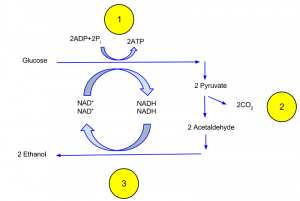
-
40 Allahumma Duas in Arabic Text with their Meanings
Allahumma duas are powerful supplications. They begin with “Allahumma,” which means “O Allah.” These Allahumma duas are a direct way to ask Allah for help. They cover different areas of life, from guidance to forgiveness. By reciting Allahumma duas, Muslims seek closeness to Allah. The simplicity of these prayers makes them easy to memorize. They…
-
40 Rabbana Duas – Their Meanings & Benefits
The 40 “Rabbana” Duas are a collection of powerful supplications found in the Qur’an. Each begins with the word “Rabbana,” meaning “Our Lord.” These Duas were made by prophets and believers in various situations, seeking Allah’s mercy, guidance, forgiveness, and blessings. Reciting these Duas helps build a strong connection with Allah, offering comfort and hope…
-
Full Quran Recitation Online by Mishary Rashid Alafsay
Listen and download the Full Quran Recitation by Mishary Rashid Alafsay. The Qur’an is the holy book of Islam. It is considered the word of Allah. Muslims believe it was revealed to the Prophet Muhammad (PBUH). The revelation took place over 23 years. It began in 610 CE and concluded in 632 CE. The Structure…






